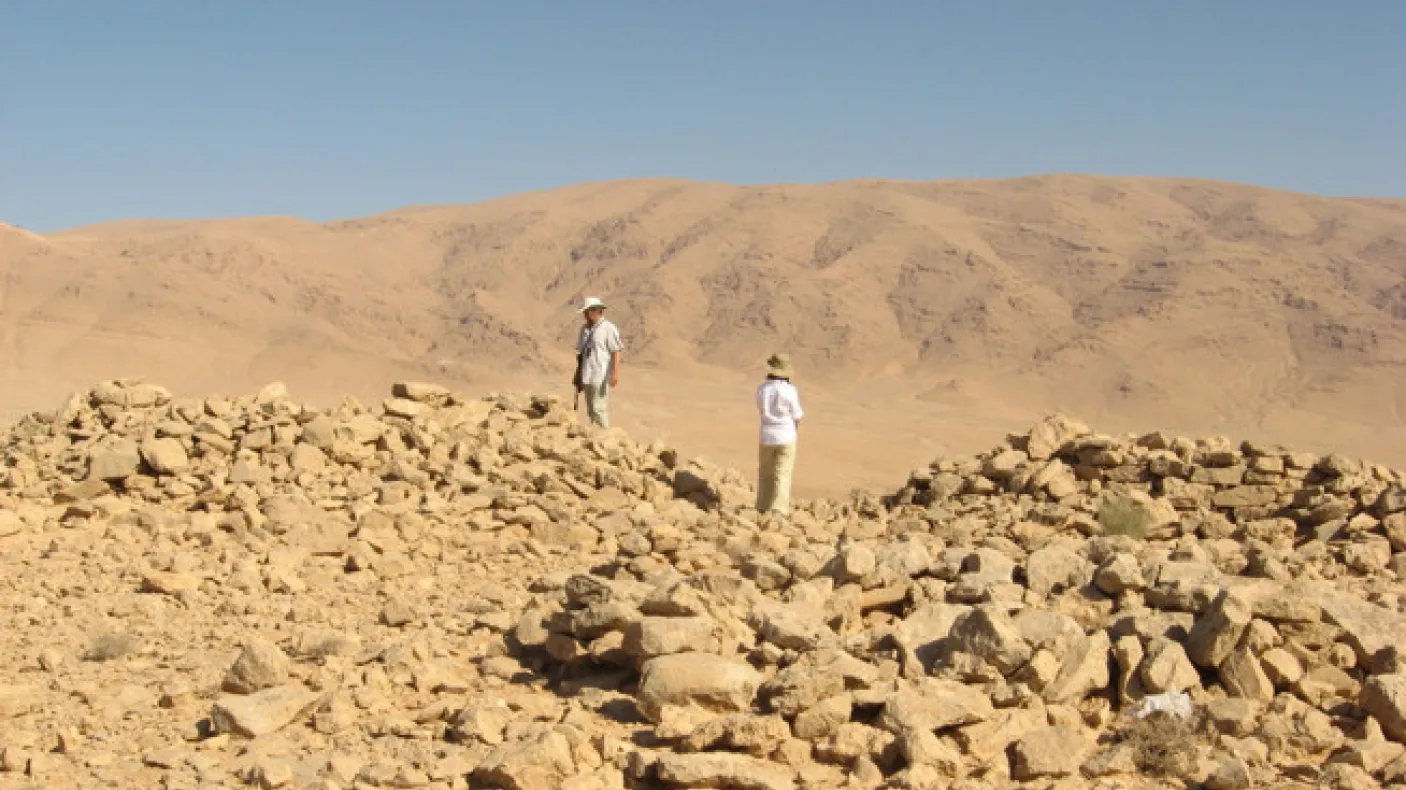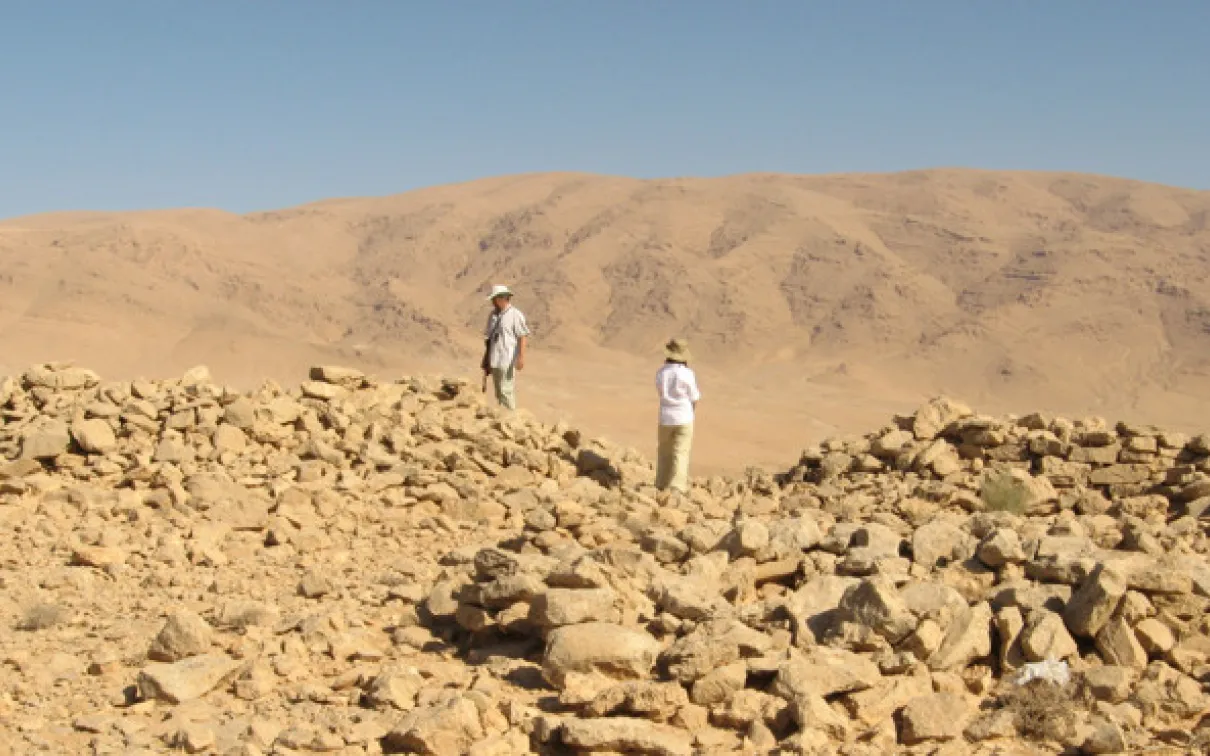The Monastery of St Moses, Syria: The Prehistoric Remains
Published
Categories
Author
Blog Post
Since 2004 I had walked the Qalamoun mountains around the monastery of Deir Mar Musa looking for archaeological features to record. In all that time I found one lithic, a stone tool from humanity’s prehistoric past. My colleagues back home that specialised in these objects would say that I just didn’t know what I was looking for. In the last days of the 2009 season, what turned out to be my last season at the monastery, I thought I would reconnoitre the southern part of the field area. Here lay a range of low hills that ran parallel to the high Qalamoun upon which sat the monastery.
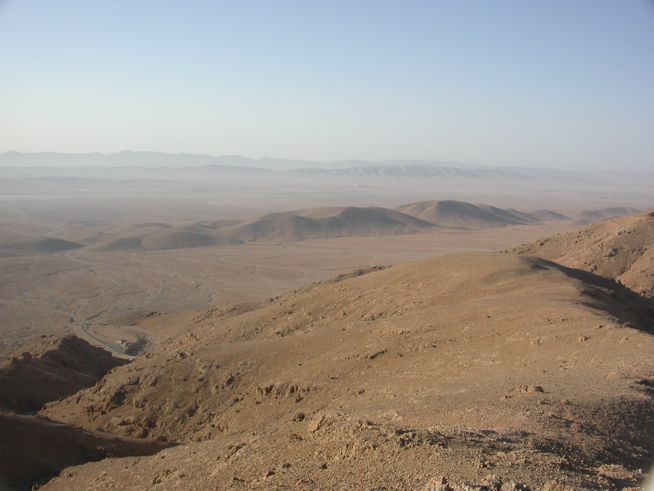
This photograph taken while surveying the Qalamoun around the monastery shows the valley below the monastery, and in the middle distance the low range of hills that marked the extent of my field area.
The approach road to the monastery went past these hills, and I had noticed piles of rocks on top of some them. The first building at the monastery itself was thought to be a Roman watchtower, and Roman watchtowers are always built in line of sight of each other, to signal at the approach of danger. I was hoping that a reconnaissance of these hills would settle that business, but instead I found something completely unexpected, what seemed to be a Prehistoric landscape.
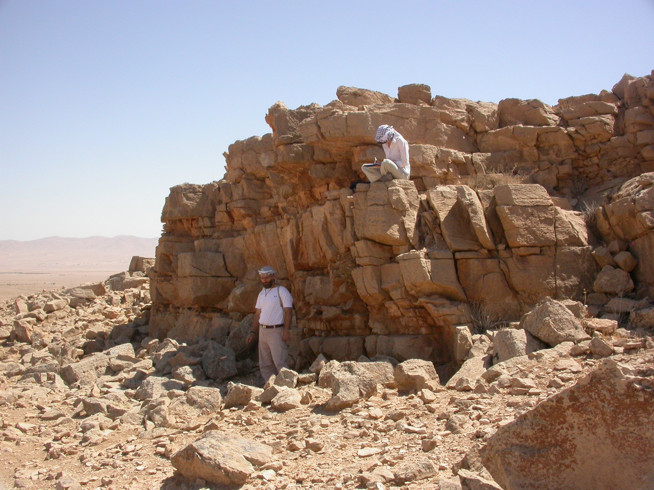
The largely natural outcrop we called "Lion Rock" (Feature 49), which seems to be the centre of a Prehistoric landscape, with then Br. Jihad and Julia Tugwell.
The focus of the landscape seemed to be a limestone rock outcrop with a flat top. It would not have been a significant feature in the Qalamoun, but in these low hills it was a major landmark. At the time I dubbed it "Lion rock", a name that is convenient to continue to use! Such natural features would have providing prehistoric people with a point of reference for generations of hunting and gathering, following the herds of gazelle across the desert. Lion Rock's flat top would have made it a good candidate to be the site of ritual activities by these prehistoric hunter-gatherers. It also had another, more evident use, a series of round holes in the rock face show where nodules of chert had been broken out of the limestone. The chert had been used to make stone tools, the only resource of this type I have found in the region. Using stone mauls, the rock had been quarried out to obtain the chert.
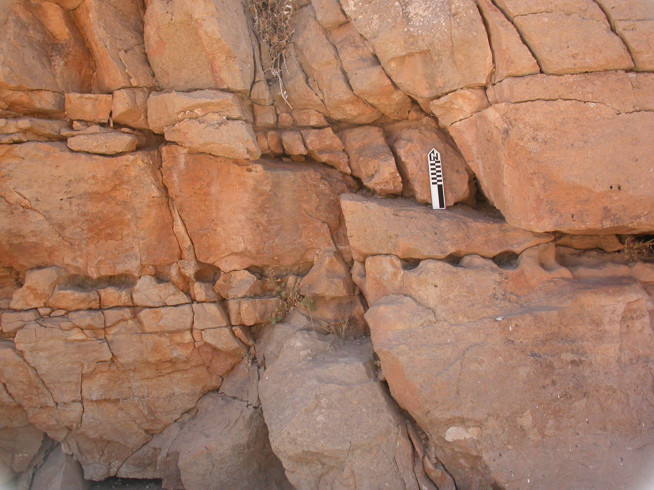
The face of Lion Rock with voids left by chert nodules, quarried out by Prehistoric humans.
Arranged around Lion Rock were a group of 6 roughly circular stone structures, each about 2.5 metres in diameter. The ones nearest Lion Rock were of orthostatic construction, with larger upright stones, but others were of corbelled construction, made of smaller stones that started to come closer to the centre, and presumably originally came together to create a corbelled dome. At least one of these structures was built right up against the face of Lion Rock, covering the quarried part. Thus so far we have at least two phases, with the first phase being the quarying of Lion Rock, and the second phase being the stone structures, with perhaps the orthostatic structures being earlier than the corbelled structures.
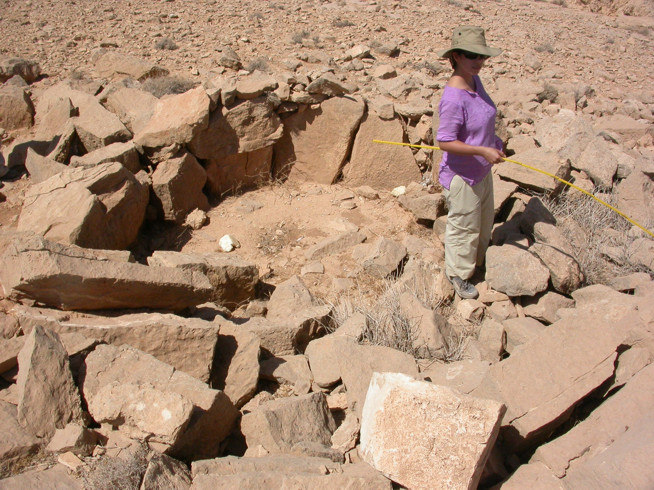
Here Whitney Hahn measures one of the orthostatic structures Feature 45)
About 73 metres south of Lion Rock was a group of a further 3 corbelled structures, presumably part of the same complex. Radiating from Lion Rock were a number of alignments of stones, none of them large, but still distinctly running across the landscape. One alignment that we had time to study (Feature 44) was 363 metres long running from Lion Rock north to a another corbelled structure (Feature 43). Unlike the other corbelled structures, in this case Feature 43 had an associated circle of stones about 8 metres in diameter. Conceivably the alignment provided a physical link to Lion Rock for the corbelled structure, and the lack of Lion Rock in near proximity necessitated the creation of the circle, perhaps for ritual purposes.
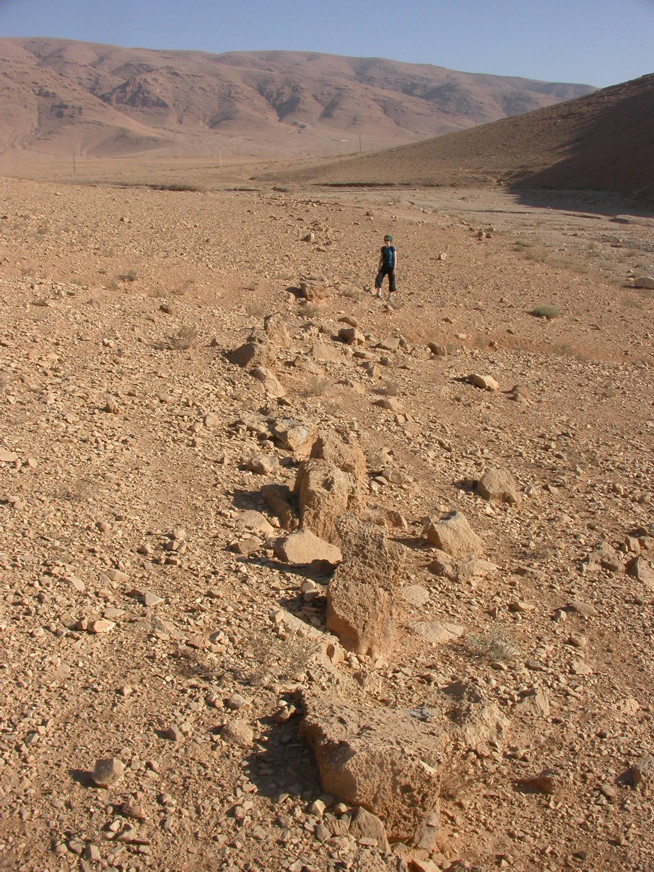
A stone alignment running north from Lion Rock towards a corbelled structure (Julia Tugwell for scale). The higher Qalamoun rise in the background.
Northeast of this feature, on the summit of the next hill in this low range, was a group of corbelled structures (Features 40-42) each with a circle of stones. These were not obviously linked to Lion Rock, but it is possible that there is a "path" of flat stone blocks going up the hill from Feature 43, as is more evident going from the wadi west of Lion Rock and going to the west.
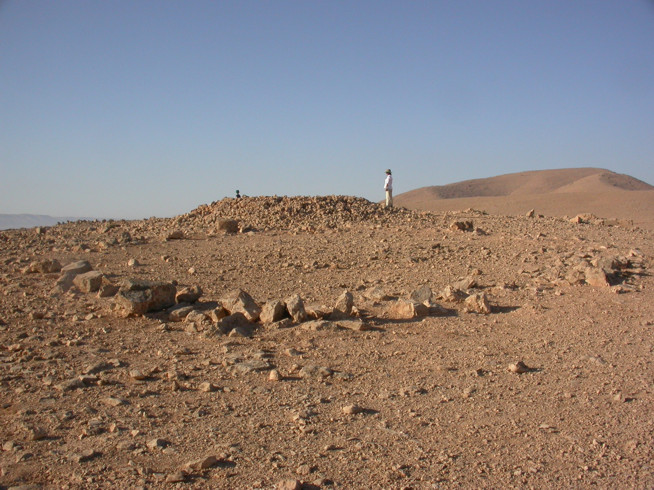
Feature 40, a corbelled structure with associated circle (Whitney Hahn for scale)
At least two other alignments seem to leave Lion Rock towards the northwest, but we did not investigate them. However, by taking a different route we found the largest complex of corbelled structures of all, three in number (Features 56-58) that seem to be at the end of one of these alignments. On the day all this was discovered, this large structure was so impressive I thought that it, too, deserved a name, and I called it "The Tomb of the Shaman King", possibly betraying some bias that had developed in my assessment of the features.
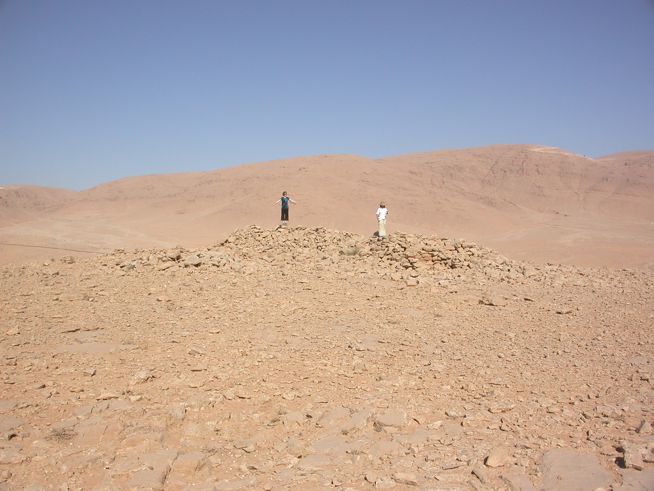
My field assistants Julia and Whitney stand in amazement on top of the "Tomb of the Shaman King", more properly known as Feature 56. In the distance are the Qalamoun, where lies Deir Mar Musa.
Leading to the west, rising from the wadi just west of Lion Rock was what appeared to be a pathway made of roughly flat rocks weaving across the landscape in a serpentine manner. This was named "Snake Path" initially, but is recorded as Feature 53. This feature petered out in a shallow depression after about 248 metres.
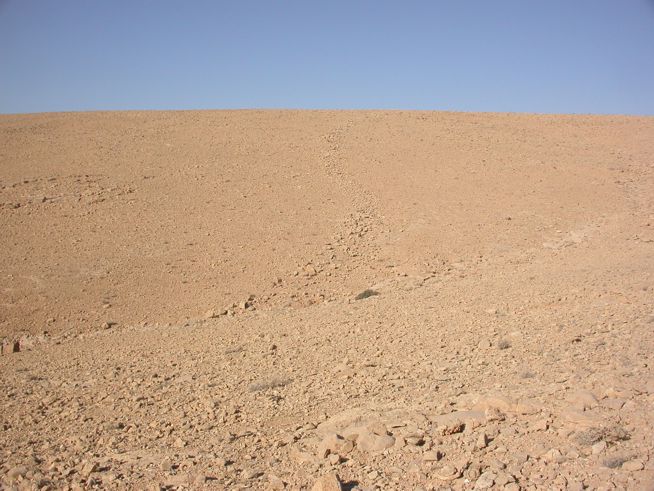
Snake Path, more properly known as Feature 53, heads to the west from Lion Rock.
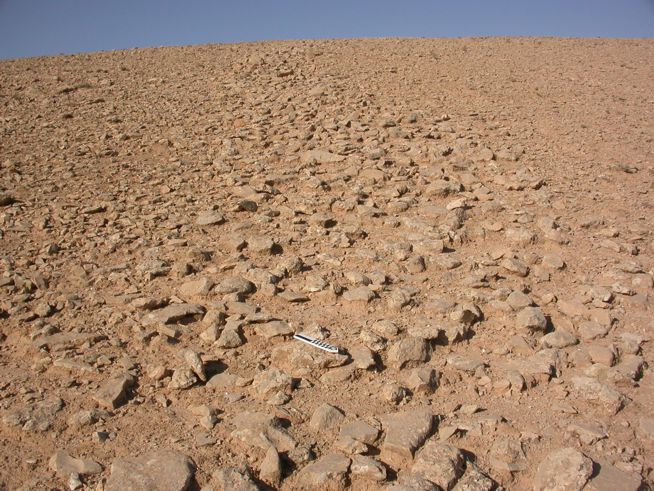
Snake Path, Feature 53, is made up of larger and flatter rocks than the surrounding landscape. Like the other features, it does not follow drainage patterns or the strata of the underlying rock, but is artificially superimposed on the landscape.
The remaining type of feature found in this landscape has a function that is better understood. Along the same ridge about 400 metres southwest of Lion Rock we found a "desert kite". Hundreds of desert kites have been identified, often from aerial photography, from the Sinai Peninsula to Northeast Syria. This covers what is thought to have been the migratory path of the Persian or goitered gazelle (Gazella subgutturosa). The Persian gazelle is listed on the International Union for Conservation of Nature and Natural Resources Red List as a threatened, vulnerable species at high risk for extinction in the wild, and these desert kites may be part of the reason for that status. They are designed to trap the migrating animals, probably being driven into the open arms of the kite, and being funneled into a kill zone. Other animals are also thought to have been trapped in these kites. Other species of gazelle, the mountain gazelle (Gazella gazella) and dorcas gazelle (Gazella dorcas) share the same vulnerable status. Species such as the hartebeest (Alcelaphus buselaphus), arabian oryx (Oryx leucoryx), and ostrich (Struthio camelus) were extirpated from the southern Levant by about four thousand years ago, and may also have been hunted using these structures.
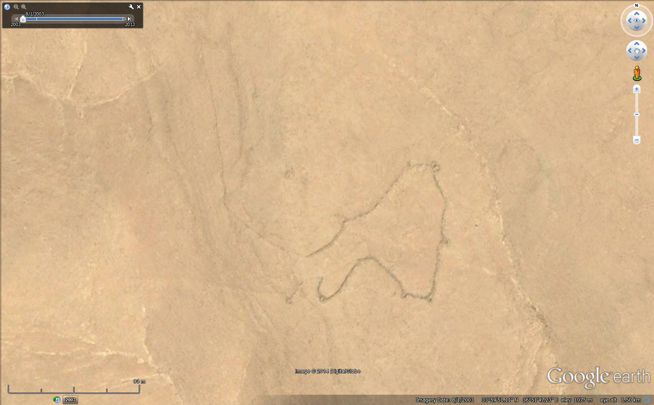
GoogleEarth photo of Feature 54, a desert kite, open to gazelles being driven into from the west. Near the southeast corner is a little blob which is actually the base of one of the corbelled structures, robbed of stone for the kite.
The dates of these kites is especially important for this landscape as it seems that one of the corbelled structures had been mostly robbed of stone in order to build the kite. Hence it is probably the last phase of the sequence, starting with the quarrying of chert on Lion Rock, the sequence of structures starting with orthostatic ones to corbelled ones, and finally the kite which destroyed one of the corbelled structures. The earliest date for a desert kite was claimed for a site in eastern Jordan, of about ten thousand years ago during Pre-Pottery Neolithic B period. In post-Neolithic times there is little evidence for Persian gazelle on archaeological sites, which are dominated by domestic species, one exception being Tell Kuran in northeast Syria, dating to somewhere between 3500 and 3100 BCE. Here 2,631 bones calculated as representing a minimum of 93 individual gazelle, were found butchered, with the main meaty parts taken on elsewhere. Studies of the smaller kites of the Sinai and Negev show they were established by about 5 thousand years ago, and ceased to function by about 1500 BCE. Apart from the kite Feature 54, we found a further kite on the walk back to the monastery on the first day (Feature 61).

Lithics from the prehistoric landscape
The only dating evidence found anywhere on the landscape were lithics: stone tools and industrial fragments like blades and cores. This astonished my colleagues who had thought that I was just not seeing these artefacts. None of the lithics had diagnostic features that would provide a more specific date, but they were considered by my colleagues to be Neolithic (starting c. 9,500 BCE), Chalcolithic (starting c.4500 BCE), or Early Bronze Age (about 3300–2100 BCE).
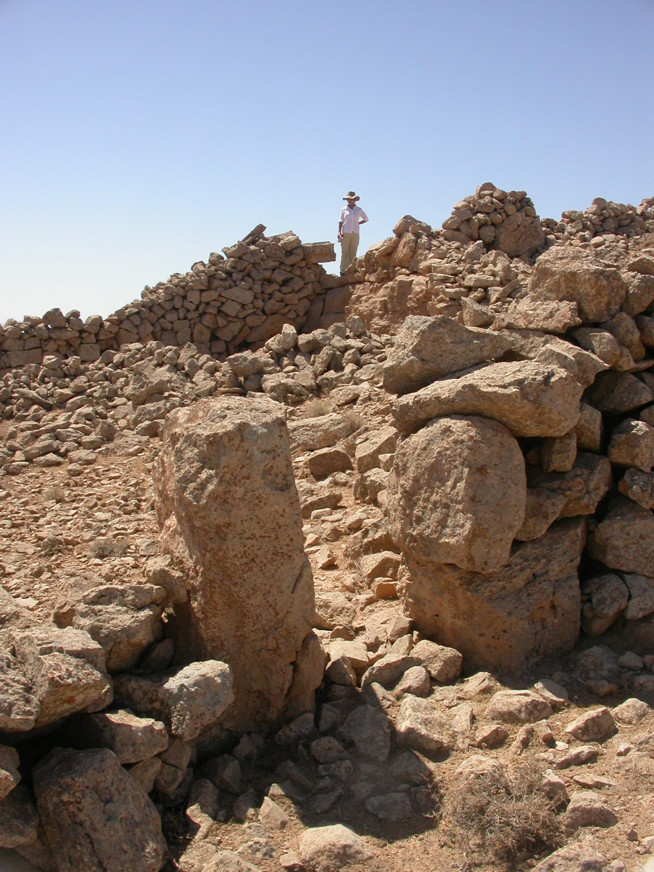
A doorway in the building associated with the second kite found, Feature 61, which is actually in the Qalamoun, but outside the field area.
Finding this entire landscape was astonishing for myself and my team, and I think the sense of amazement shows in the photographs taken with us in the picture. As an archaeologist from southern England, it was like I had suddenly walked onto Salisbury Plain, and was surrounded by this prehistoric landscape. On returning to Toronto, I gave a talk in a ROM colloquium on my findings, and in the audience was someone that then wrote a blog about it, calling it "Syria's Stonehenge". Unfortunately I became known as someone that claimed to have found Syria's stonehenge, which I had not, of course. My first instinct was that these orthostatic and corbelled structures are tombs, and the associated circles were for associated ritual, but other functions are conceivable. At that time I had not heard of anything like these structures, but similar structures had been found by others in desert areas near Palmyra and in Northern Syria, but they had found no dating evidence. In western Syria near the city of Hama had been found corbelled structures with associated rings of stones exactly like this, but since the area continued to be occupied they were surrounded by cairns of later times, up to the Roman period, and much later dating evidence was everywhere. Hence there it was not possible to extricate these structures from the palimpsest of archaeological remains.
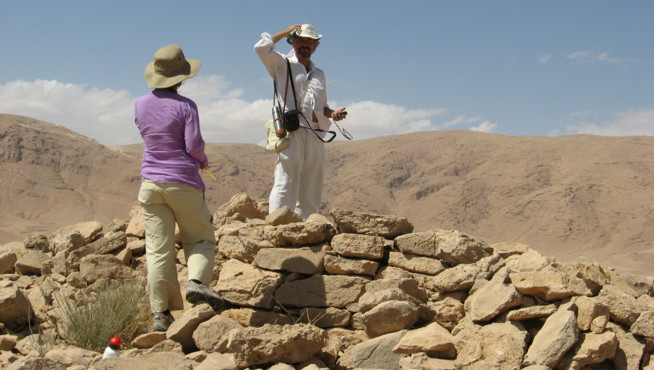
I am actually trying to keep my hat on rather than scratching my head in bemusement, but I was certainly standing on something I did not expect.
Here, in the hills near Deir Mar Musa was a possibly unusual circumstance where these structures were not overwritten by thousands of years of later activity. Using satellite photos I could see the structures, and see that they extended further along the range of hills, but except for the desert kite, there were no such structures in the Qalamoun. Looking at the photographs I could see other structures that could be signs of occupation on the slopes of these hills to the east, and small oases exist that might have been a home to early farmers about 3-4 km away. However the high Qalamoun where I had been surveying before was over 7 km away from any oases, so perhaps it would be too far away for such activities. I started to look for people to come out with me who specialised in these early periods in order to study these finds more fully, but the war came in Syria, and that didn't happen. Hence there is not enough information to publish these findings in a professional journal, but I can make them public here, to contribute to the now growing literature on enigmatic stone structures in the desert.
FURTHER READING
Arrangements of stones in the desert
Extirpation of Persian gazelle in the northern Levant
Samar Desert kites, southern Negev, Israel
NAVIGATION (links will become hot as they are published)
The Monastery of St Moses, Syria: Introduction
The Monastery of St Moses, Syria: The Pottery
The Monastery of St Moses, Syria: The Frescoes
The Monastery of St Moses, Syria: The Cave Survey
The Monastery of St Moses, Syria: The Buildings
The Monastery of St Moses, Syria: The Prehistoric Remains
The Monastery of St Moses, Syria: Conclusion and Syria Today
